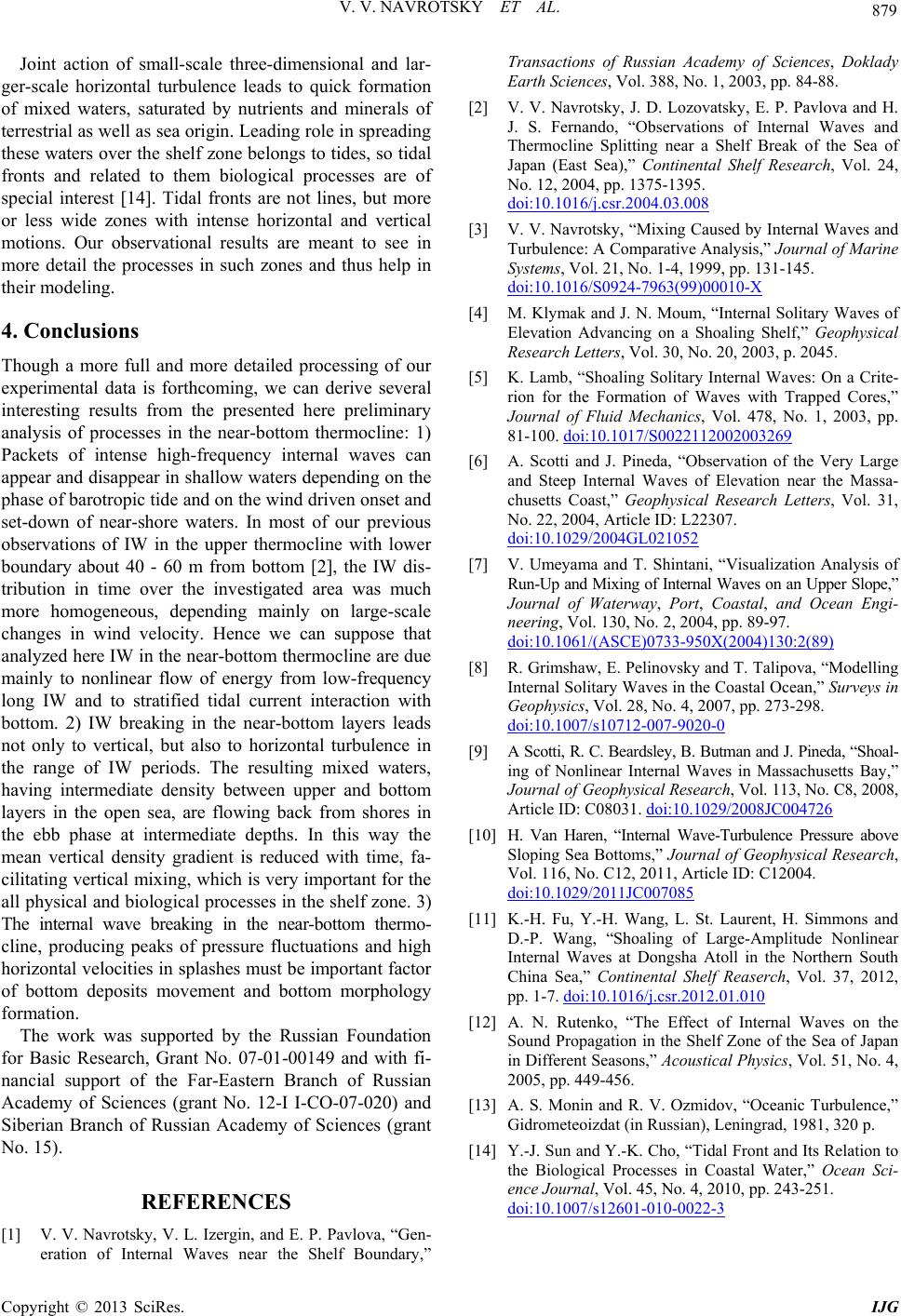
V. V. NAVROTSKY ET AL. 879
Joint action of small-scale three-dimensional and lar-
ger-scale horizontal turbulence leads to quick formation
of mixed waters, saturated by nutrients and minerals of
terrestrial as well as sea origin. Leading role in spreading
these waters over the shelf zone belongs to tides, so tidal
fronts and related to them biological processes are of
special interest [14]. Tidal fronts are not lines, but more
or less wide zones with intense horizontal and vertical
motions. Our observational results are meant to see in
more detail the processes in such zones and thus help in
their modeling.
4. Conclusions
Though a more full and more detailed processing of our
experimental data is forthcoming, we can derive several
interesting results from the presented here preliminary
analysis of processes in the near-bottom thermocline: 1)
Packets of intense high-frequency internal waves can
appear and disappear in shallow waters depending on the
phase of barotropic tide and on the wind driven onset and
set-down of near-shore waters. In most of our previous
observations of IW in the upper thermocline with lower
boundary about 40 - 60 m from bottom [2], the IW dis-
tribution in time over the investigated area was much
more homogeneous, depending mainly on large-scale
changes in wind velocity. Hence we can suppose that
analyzed here IW in the near-bottom thermocline are due
mainly to nonlinear flow of energy from low-frequency
long IW and to stratified tidal current interaction with
bottom. 2) IW breaking in the near-bottom layers leads
not only to vertical, but also to horizontal turbulence in
the range of IW periods. The resulting mixed waters,
having intermediate density between upper and bottom
layers in the open sea, are flowing back from shores in
the ebb phase at intermediate depths. In this way the
mean vertical density gradient is reduced with time, fa-
cilitating vertical mixing, which is very important for the
all physical and biological processes in the shelf zone. 3)
The internal wave breaking in the near-bottom thermo-
cline, producing peaks of pressure fluctuations and high
horizontal velocities in splashes must be important factor
of bottom deposits movement and bottom morphology
formation.
The work was supported by the Russian Foundation
for Basic Research, Grant No. 07-01-00149 and with fi-
nancial support of the Far-Eastern Branch of Russian
Academy of Sciences (grant No. 12-I I-CO-07-020) and
Siberian Branch of Russian Academy of Sciences (grant
No. 15).
REFERENCES
[1] V. V. Navrotsky, V. L. Izergin, and E. P. Pavlova, “Gen-
eration of Internal Waves near the Shelf Boundary,”
Transactions of Russian Academy of Sciences, Doklady
Earth Sciences, Vol. 388, No. 1, 2003, pp. 84-88.
[2] V. V. Navrotsky, J. D. Lozovatsky, E. P. Pavlova and H.
J. S. Fernando, “Observations of Internal Waves and
Thermocline Splitting near a Shelf Break of the Sea of
Japan (East Sea),” Continental Shelf Research, Vol. 24,
No. 12, 2004, pp. 1375-1395.
doi:10.1016/j.csr.2004.03.008
[3] V. V. Navrotsky, “Mixing Caused by Internal Waves and
Turbulence: A Comparative Analysis,” Journal of Marine
Systems, Vol. 21, No. 1-4, 1999, pp. 131-145.
doi:10.1016/S0924-7963(99)00010-X
[4] M. Klymak and J. N. Moum, “Internal Solitary Waves of
Elevation Advancing on a Shoaling Shelf,” Geophysical
Research Letters, Vol. 30, No. 20, 2003, p. 2045.
[5] K. Lamb, “Shoaling Solitary Internal Waves: On a Crite-
rion for the Formation of Waves with Trapped Cores,”
Journal of Fluid Mechanics, Vol. 478, No. 1, 2003, pp.
81-100. doi:10.1017/S0022112002003269
[6] A. Scotti and J. Pineda, “Observation of the Very Large
and Steep Internal Waves of Elevation near the Massa-
chusetts Coast,” Geophysical Research Letters, Vol. 31,
No. 22, 2004, Article ID: L22307.
doi:10.1029/2004GL021052
[7] V. Umeyama and T. Shintani, “Visualization Analysis of
Run-Up and Mixing of Internal Waves on an Upper Slope,”
Journal of Waterway, Port, Coastal, and Ocean Engi-
neering, Vol. 130, No. 2, 2004, pp. 89-97.
doi:10.1061/(ASCE)0733-950X(2004)130:2(89)
[8] R. Grimshaw, E. Pelinovsky and T. Talipova, “Modelling
Internal Solitary Waves in the Coastal Ocean,” Surveys in
Geophysics, Vol. 28, No. 4, 2007, pp. 273-298.
doi:10.1007/s10712-007-9020-0
[9] A Scotti, R. C. Beardsley, B. Butman and J. Pineda, “Shoal-
ing of Nonlinear Internal Waves in Massachusetts Bay,”
Journal of Geophysical Research, Vol. 113, No. C8, 2008,
Article ID: C08031. doi:10.1029/2008JC004726
[10] H. Van Haren, “Internal Wave-Turbulence Pressure above
Sloping Sea Bottoms,” Journal of Geophysical Research,
Vol. 116, No. C12, 2011, Article ID: C12004.
doi:10.1029/2011JC007085
[11] K.-H. Fu, Y.-H. Wang, L. St. Laurent, H. Simmons and
D.-P. Wang, “Shoaling of Large-Amplitude Nonlinear
Internal Waves at Dongsha Atoll in the Northern South
China Sea,” Continental Shelf Reaserch, Vol. 37, 2012,
pp. 1-7. doi:10.1016/j.csr.2012.01.010
[12] A. N. Rutenko, “The Effect of Internal Waves on the
Sound Propagation in the Shelf Zone of the Sea of Japan
in Different Seasons,” Acoustical Physics, Vol. 51, No. 4,
2005, pp. 449-456.
[13] A. S. Monin and R. V. Ozmidov, “Oceanic Turbulence,”
Gidrometeoizdat (in Russian), Leningrad, 1981, 320 p.
[14] Y.-J. Sun and Y.-K. Cho, “Tidal Front and Its Relation to
the Biological Processes in Coastal Water,” Ocean Sci-
ence Journal, Vol. 45, No. 4, 2010, pp. 243-251.
doi:10.1007/s12601-010-0022-3
Copyright © 2013 SciRes. IJG